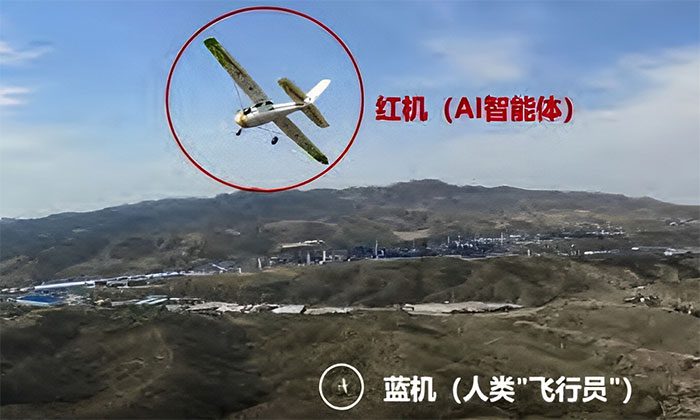Researchers in the Chinese military conducted a one-on-one combat test between AI-controlled drones and manned aircraft in a real-world setting.
The artificial intelligence machine displayed superior performance in combat, often putting its opponent at a disadvantage. The research team published the results of their experimental combat in the journal Acta Aeronautica et Astronautica Sinica on February 27, just a month after the U.S. military reported that AI pilots had recently completed numerous test missions, including combat exercises on F-16 fighter jets.

AI-controlled drone (highlighted in red) defeats remote-piloted aircraft. (Photo: Chinese Aerodynamics Research and Development Center).
The aerial dogfight involved two small fixed-wing aircraft, one controlled by an AI pilot in the cockpit and the other remotely piloted by a ground-based pilot. As the battle commenced, the human pilot moved first to gain the upper hand. However, the AI pilot anticipated the opponent’s intentions, countering effectively and keeping close on their tail.
The human-controlled aircraft dove down to lure the AI-operated drone into a nosedive. The AI pilot then maneuvered into an ambush position, waiting for the opponent to ascend. The human pilot attempted various tactics, such as sudden deceleration combined with changes in flight path, hoping the AI would overshoot its target during the chase. The research team halted the tests after approximately 90 seconds, as the human pilot could not escape the AI’s grasp.
The project was directed by Professor Huang Juntao at the Chinese Aerodynamics Research and Development Center in Sichuan province, which specializes in the development and testing of future weapon technologies. “Aircraft with the ability to make autonomous decisions can completely outpace humans in terms of reaction speed,” Huang and his colleagues concluded.
When maneuvering sharply, AI does not hesitate like humans do, for example, by experiencing blood rushing from the brain due to excessive gravitational forces or fear of harm. With its superior computational abilities, it can more accurately predict the progression of the battle to seize the initiative in confrontations. Thanks to advancements in stealth technology and electronic countermeasures, 25% to 40% of aerial combat may occur at close range in the future. Research on such combat scenarios holds significant practical value.
The Huang research team did not specify the location of the test flights, but they took place before October 2022 when the paper was submitted. Implementing AI in the skies is much more challenging than on the ground. Limited computational resources on aircraft can significantly reduce the performance of AI pilots. The real-world environment is also far more complex and unpredictable compared to simulations created by mathematical models. Engineers will have to carefully weigh the costs and risks of accidents. Huang and colleagues stated that the next generation of AI pilots is being developed to learn during actual flights and improve performance without ground support.


















































